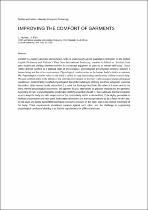JavaScript is disabled for your browser. Some features of this site may not work without it.
- ResearchSpace
- →
- Research Publications/Outputs
- →
- Book Chapters
- →
- View Item
| dc.contributor.author |
Hunter, Lawrance

|
|
| dc.contributor.author |
Fan, J

|
|
| dc.date.accessioned | 2015-08-19T10:39:07Z | |
| dc.date.available | 2015-08-19T10:39:07Z | |
| dc.date.issued | 2014-11 | |
| dc.identifier.citation | Hunter, L and Fan, J. 2014. Improving the comfort of garments. In: Textiles and Fashion: Materials, Design and Technology. Woodhead Publishing: Sawston, Cambridge | en_US |
| dc.identifier.isbn | 978-1-84569-931-4 | |
| dc.identifier.uri | http://hdl.handle.net/10204/8040 | |
| dc.identifier.uri | https://doi.org/10.1016/B978-1-84569-931-4.00029-5 | |
| dc.identifier.uri | https://www.sciencedirect.com/book/9781845699314/textiles-and-fashion | |
| dc.description | Copyright: Woodhead Publishing: Sawston, Cambridge. Due to copyright restrictions, the attached PDF file only contains the abstract of the full text item. For access to the full text item, please consult the publisher's website. | en_US |
| dc.description.abstract | Comfort is a highly subjective phenomenon, with no unanimously agreed quantitative definition. In the Oxford English Dictionary and Webster’s Third New International Dictionary, comfort is defined as ‘freedom from pain, trouble and anxiety; therefore comfort is a contented enjoyment in physical or mental well-being’. Slater (1986) defined comfort as a pleasant state of physiological, psychological and physical harmony between a human being and his or her environment. Physiological comfort refers to the human body’s ability to maintain life. Psychological comfort refers to the mind’s ability to keep functioning satisfactorily without external help. Physical comfort refers to the effects of the external environment on the body’s physiological and psychological equilibrium. Smith (1986) classified physiological discomfort relating to clothing into three categories: sensorial discomfort, better termed tactile discomfort (i.e. what the fabric/garment feels like when it is worn next to the skin); thermo-physiological discomfort; and garment fit (i.e. restrictions or pressure imposed by the garment). According to Fan, a physiologically comfortable clothing ensemble should: 1) have adequate thermal insulation so as to keep the body and skin temperature of the human body within a narrow limit; 2) be highly permeable to moisture transmission and have good liquid water absorption and transport properties so as to keep the skin dry; 3) not cause any tactile discomfort;not impose excessive pressure on the body; and 4) not restrict movement of the body. These requirements sometimes compete against each other, and the challenge in engineering physiological comfort of clothing is to find the right balance for different end uses. | en_US |
| dc.language.iso | en | en_US |
| dc.publisher | Elsevier | en_US |
| dc.relation.ispartofseries | Workflow;14225 | |
| dc.subject | Textiles | en_US |
| dc.subject | Garments | en_US |
| dc.subject | Fabrics | en_US |
| dc.subject | Garment functionality | en_US |
| dc.title | Improving the comfort of garments | en_US |
| dc.type | Book Chapter | en_US |
| dc.identifier.apacitation | Hunter, L., & Fan, J. (2014). Improving the comfort of garments., <i>Workflow;14225</i> Elsevier. http://hdl.handle.net/10204/8040 | en_ZA |
| dc.identifier.chicagocitation | Hunter, Lawrance, and J Fan. "Improving the comfort of garments" In <i>WORKFLOW;14225</i>, n.p.: Elsevier. 2014. http://hdl.handle.net/10204/8040. | en_ZA |
| dc.identifier.vancouvercitation | Hunter L, Fan J. Improving the comfort of garments.. Workflow;14225. [place unknown]: Elsevier; 2014. [cited yyyy month dd]. http://hdl.handle.net/10204/8040. | en_ZA |
| dc.identifier.ris | TY - Book Chapter AU - Hunter, Lawrance AU - Fan, J AB - Comfort is a highly subjective phenomenon, with no unanimously agreed quantitative definition. In the Oxford English Dictionary and Webster’s Third New International Dictionary, comfort is defined as ‘freedom from pain, trouble and anxiety; therefore comfort is a contented enjoyment in physical or mental well-being’. Slater (1986) defined comfort as a pleasant state of physiological, psychological and physical harmony between a human being and his or her environment. Physiological comfort refers to the human body’s ability to maintain life. Psychological comfort refers to the mind’s ability to keep functioning satisfactorily without external help. Physical comfort refers to the effects of the external environment on the body’s physiological and psychological equilibrium. Smith (1986) classified physiological discomfort relating to clothing into three categories: sensorial discomfort, better termed tactile discomfort (i.e. what the fabric/garment feels like when it is worn next to the skin); thermo-physiological discomfort; and garment fit (i.e. restrictions or pressure imposed by the garment). According to Fan, a physiologically comfortable clothing ensemble should: 1) have adequate thermal insulation so as to keep the body and skin temperature of the human body within a narrow limit; 2) be highly permeable to moisture transmission and have good liquid water absorption and transport properties so as to keep the skin dry; 3) not cause any tactile discomfort;not impose excessive pressure on the body; and 4) not restrict movement of the body. These requirements sometimes compete against each other, and the challenge in engineering physiological comfort of clothing is to find the right balance for different end uses. DA - 2014-11 DB - ResearchSpace DP - CSIR KW - Textiles KW - Garments KW - Fabrics KW - Garment functionality LK - https://researchspace.csir.co.za PY - 2014 SM - 978-1-84569-931-4 T1 - Improving the comfort of garments TI - Improving the comfort of garments UR - http://hdl.handle.net/10204/8040 ER - | en_ZA |






